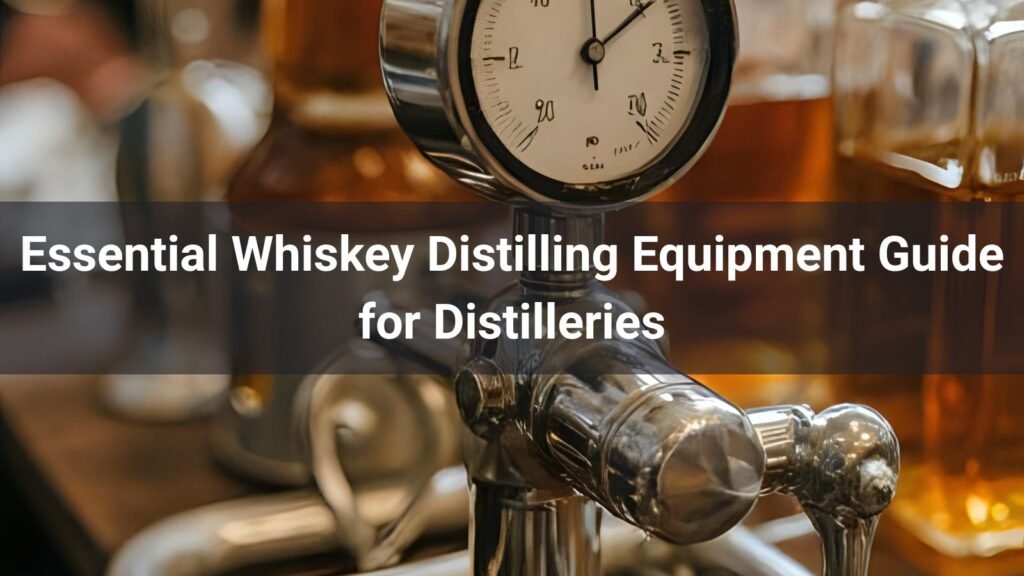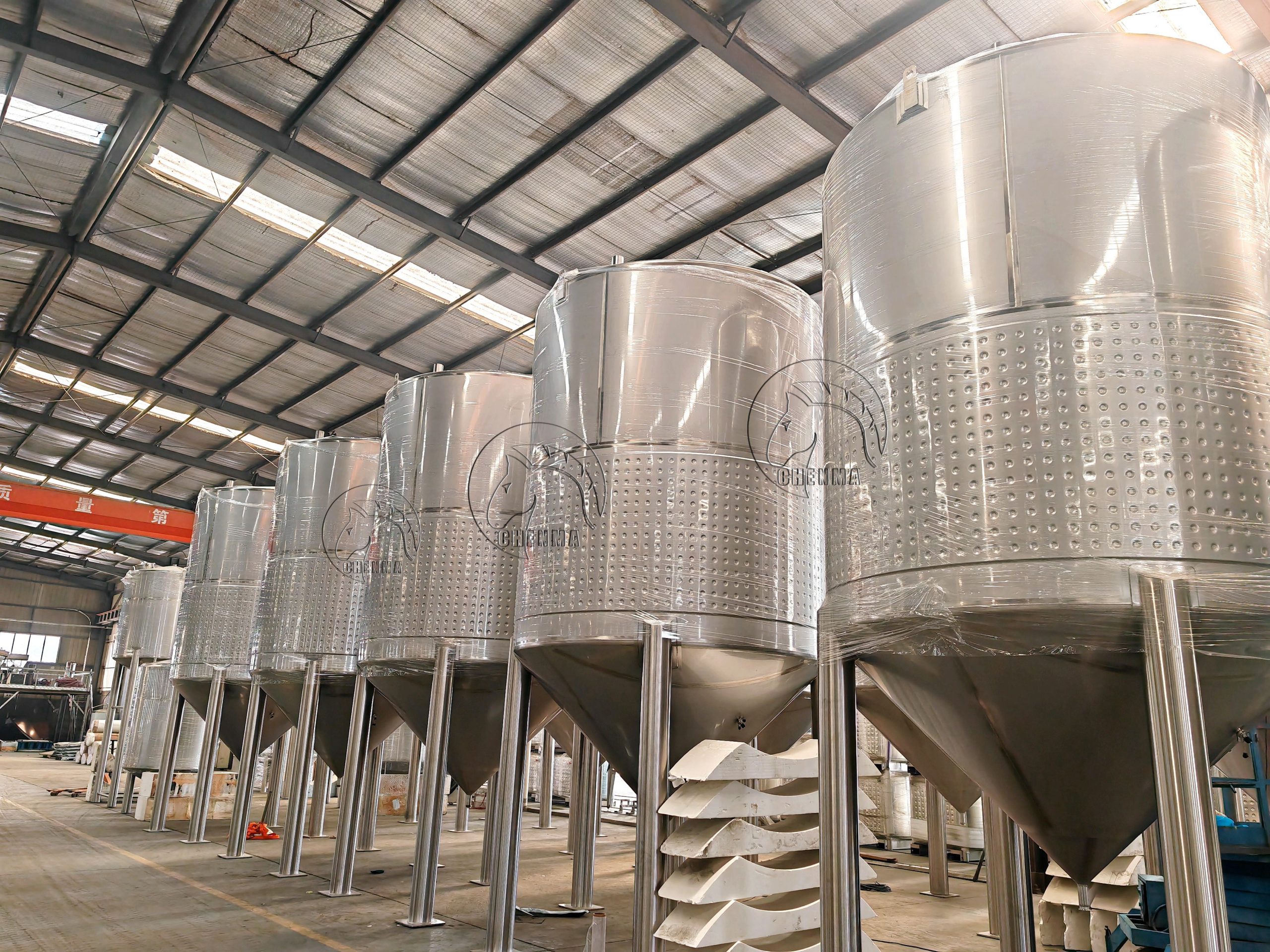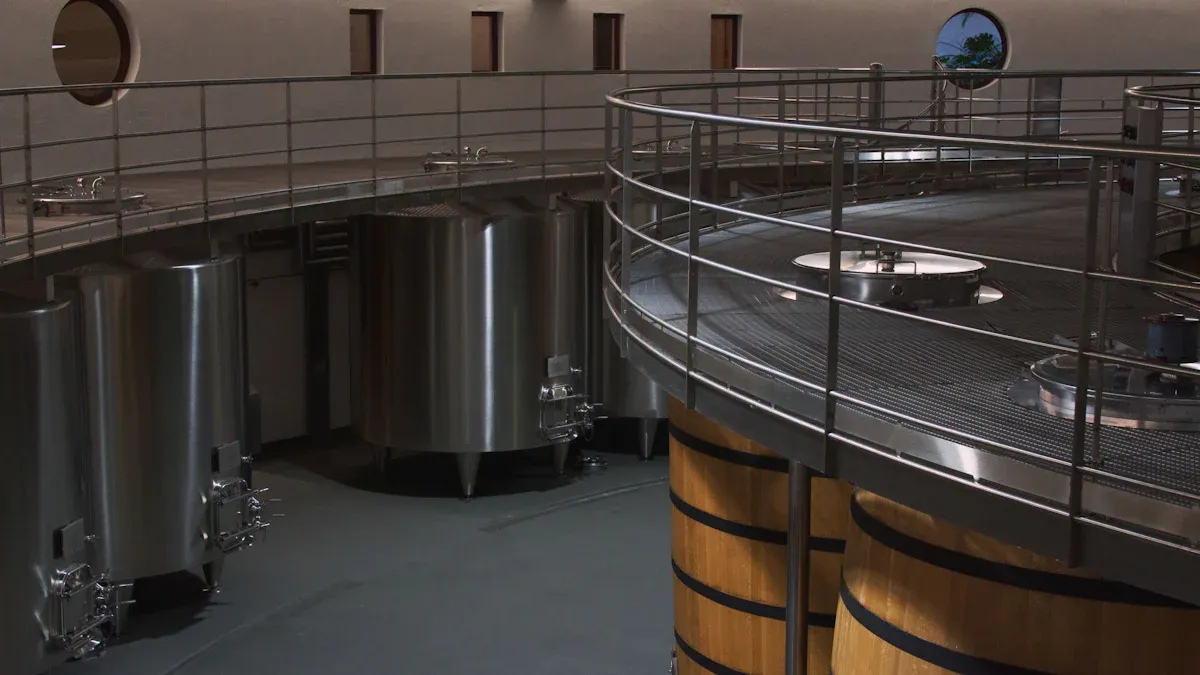
Table of Contents
Setting up a whiskey distillery requires careful selection of specialized distilling equipment that ensures quality production and operational efficiency. From fermentation tanks to sophisticated distillation columns, each component plays a crucial role in creating premium whiskey. This comprehensive guide explores the essential equipment needed for whiskey distillation, helping distillery owners make informed decisions about their investment in brewing infrastructure.
Basic Process of Whiskey Brewing
Understanding the whiskey production process is fundamental before investing in distilling equipment. The whiskey brewing process involves several critical stages, each requiring specific equipment for optimal results.
The journey begins with mashing, where grains are combined with hot water to convert starches into fermentable sugars. This process requires a mash tun with precise temperature control capabilities. Following mashing, the wort (liquid containing dissolved sugars) undergoes fermentation, where yeast converts sugars into alcohol and carbon dioxide.
| Process Stage | Duration | Key Equipment | Temperature Range |
|---|---|---|---|
| Mashing | 2-4 hours | Mash Tun | 60-70°C |
| Fermentation | 3-7 days | Fermentation Tanks | 25-32°C |
| First Distillation | 6-8 hours | Wash Still | 78-100°C |
| Second Distillation | 4-6 hours | Spirit Still | 78-85°C |
The fermentation stage is particularly crucial, as it determines the alcohol content and flavor profile foundation. Proper fermentation tank selection ensures optimal yeast activity and consistent results. The fermented wash then undergoes distillation, typically performed twice in copper pot stills or column stills, depending on the desired whiskey style.
Types of Distilling Equipment Required for Distilling Distilleries
A complete whiskey distillery requires various specialized equipment components, each serving a specific function in the production process. Understanding these equipment types helps distillery owners make informed purchasing decisions.
Distillery Heat Source
The heat source is the foundation of any distillation operation, providing the energy necessary to vaporize alcohol during the distillation process. Modern distilleries typically employ steam heating systems, direct flame heating, or electric heating elements.
Steam heating offers the most precise temperature control, making it ideal for large-scale operations. Direct flame heating, traditionally used with copper pot stills, provides authentic flavor development but requires skilled operation. Electric heating systems offer clean, efficient operation suitable for smaller craft distilleries.
Distiller
The distiller, or still, represents the heart of whiskey production equipment. Two primary types dominate the industry: pot stills and column stills. Pot stills, traditionally made from copper, excel at producing flavorful, character-rich spirits through batch distillation. Column stills enable continuous operation and higher alcohol concentrations, making them suitable for large-volume production.
Copper construction remains preferred due to its excellent heat conductivity and ability to remove sulfur compounds, enhancing final product quality. Industrial stainless steel tanks are also increasingly popular for their durability and easier maintenance requirements.
Condenser
Condensers convert alcohol vapors back into liquid form, completing the distillation cycle. Shell-and-tube condensers offer efficient heat exchange and are suitable for larger operations. Worm tub condensers, featuring a coiled copper pipe immersed in cold water, provide traditional cooling methods favored by many craft distilleries.
Proper condenser sizing ensures adequate cooling capacity during peak production periods. Insufficient condensing capacity can create bottlenecks and reduce overall distillery efficiency.
Fermenter
Fermentation vessels, or fermenters, house the crucial fermentation process where yeast converts sugars into alcohol. Modern fermenters are typically constructed from stainless steel, offering durability, easy cleaning, and precise temperature control capabilities.
Fermenter design considerations include capacity matching production goals, cooling jacket integration for temperature control, and appropriate agitation systems. Stainless steel fermenters provide numerous benefits including corrosion resistance, easy sanitization, and long service life.
Wort Tub
Wort tubs, also known as mash tuns, facilitate the initial grain processing stage where starches convert to fermentable sugars. These vessels require robust construction to handle high temperatures and acidic conditions created during mashing.
Modern wort tubs feature false bottoms for grain separation, efficient heating systems for temperature control, and adequate agitation to ensure uniform mixing. Proper sizing ensures sufficient capacity for planned production volumes while maintaining temperature uniformity throughout the vessel.
Other Auxiliary Equipment
Supporting equipment enhances distillery efficiency and product quality. This includes pumps for liquid transfer, heat exchangers for energy recovery, storage tanks for raw materials and finished products, and cleaning-in-place (CIP) systems for equipment sanitization.
Mixing tanks play essential roles in various distillery processes, from ingredient blending to final product preparation. Quality storage solutions ensure product integrity throughout the aging process.
How to Choose Whiskey Brewing Equipment?
Selecting appropriate whiskey brewing equipment requires careful consideration of multiple factors that impact both initial investment and long-term operational success.
Production Scale
Production capacity goals drive equipment sizing decisions. Small craft distilleries might start with 500-gallon fermenters and corresponding still sizes, while larger operations require thousands of gallons capacity. Understanding 500-gallon stainless steel tank pricing helps budget planning for smaller operations.
Consider future expansion plans when sizing equipment. Modular systems allow gradual capacity increases without complete equipment replacement, providing flexibility as business grows.
Equipment Budget
Budget constraints significantly influence equipment selection. Balance initial capital investment with long-term operational costs, including energy consumption, maintenance requirements, and replacement schedules.
| Equipment Type | Budget Range (USD) | Key Factors |
|---|---|---|
| 500L Fermenter | $15,000 – $25,000 | Material, cooling system |
| Copper Pot Still (1000L) | $50,000 – $80,000 | Copper quality, design complexity |
| Column Still System | $100,000 – $300,000 | Automation, capacity, plates |
Consider financing options and potential return on investment when evaluating equipment purchases. Quality equipment often provides better long-term value despite higher initial costs.
Material Selection
Material choice impacts equipment performance, maintenance requirements, and product quality. Stainless steel offers excellent corrosion resistance and easy cleaning, making it ideal for fermenters and storage vessels. Copper remains preferred for stills due to its catalytic properties and heat transfer characteristics.
Stainless steel benefits extend beyond durability, including improved hygiene standards and reduced maintenance costs. Consider material compatibility with planned products and cleaning procedures.
Automation Level
Automation reduces labor requirements and improves consistency but increases initial investment. Evaluate automation needs based on production volume, available skilled labor, and quality consistency requirements.
Basic automation might include temperature monitoring and control, while advanced systems incorporate complete process control, data logging, and remote monitoring capabilities.
Supplier Support
Reliable supplier support ensures smooth equipment installation, operation, and maintenance. Evaluate suppliers based on experience, technical expertise, after-sales support, and spare parts availability.
At sdchenma.com, Shandong Chenma Machinery Co., Ltd. provides comprehensive support including process design, equipment manufacturing, installation, commissioning, and technical training. Our team of over 200 professionals ensures quality equipment backed by reliable service.
Whiskey Distilling Equipment Maintenance
Regular maintenance ensures optimal equipment performance, extends service life, and maintains product quality. Develop comprehensive maintenance schedules covering all equipment components.
Daily maintenance includes visual inspections, cleaning procedures, and operational parameter verification. Weekly tasks might involve detailed cleaning, lubrication, and calibration checks. Monthly maintenance covers major component inspections and preventive replacements.
Maintaining stainless steel fermentation tanks requires specific procedures to preserve sanitary conditions and prevent contamination. Proper maintenance protocols protect both equipment investment and product quality.
Establish relationships with qualified maintenance technicians and ensure adequate spare parts inventory. Document all maintenance activities to track equipment performance trends and plan replacements.
Frequently Asked Questions
What are the main components of whiskey distillation equipment?
The main components include fermentation tanks, mash tuns, distillation stills (pot or column), condensers, heat sources, and various auxiliary equipment like pumps, heat exchangers, and storage vessels. Each component plays a specific role in converting raw grains into finished whiskey.
What factors should be considered when choosing a distiller?
Key factors include production capacity requirements, desired whiskey style, available space, budget constraints, energy efficiency, automation level, and supplier support. Copper pot stills excel for flavor development, while column stills offer efficiency for larger production volumes.
How to ensure the safety of the distillation process?
Safety requires proper ventilation systems, explosion-proof electrical equipment, emergency shutdown procedures, regular equipment inspections, staff training, and compliance with local safety regulations. Install gas detection systems and maintain proper grounding for all electrical equipment.
How important is the cleaning and maintenance of the equipment?
Equipment cleanliness and maintenance are crucial for product quality, equipment longevity, and regulatory compliance. Proper sterilization procedures prevent contamination and ensure consistent product quality. Regular maintenance prevents costly breakdowns and extends equipment life.
What is the importance of supplier support?
Reliable supplier support ensures proper equipment installation, staff training, troubleshooting assistance, spare parts availability, and ongoing technical guidance. Choose suppliers with proven experience, comprehensive support services, and long-term commitment to customer success.
Contact Shandong Chenma Machinery Co., Ltd.
For professional whiskey distilling equipment solutions, contact our experienced team:
- Website: sdchenma.com
- WhatsApp: +86 180 6342 1809
- Email: admin@sdchenma.com
- Address: Pingyuan County Economic Development Zone, Dezhou City, Shandong Province
With over 200 professionals and a 20,000 m² production facility, we provide turnkey solutions for distillery equipment needs, from initial design to final commissioning and training.




